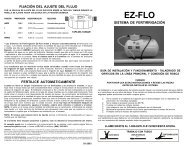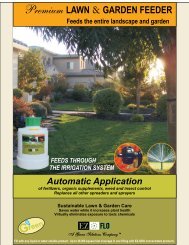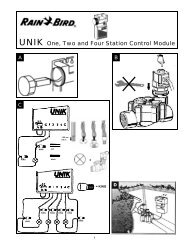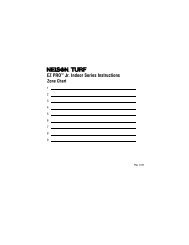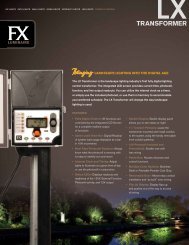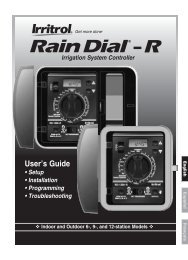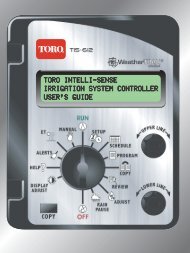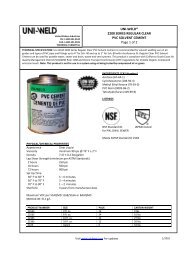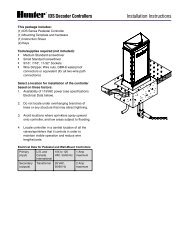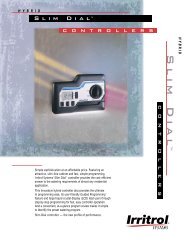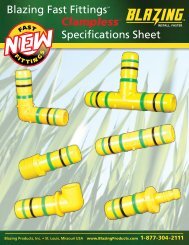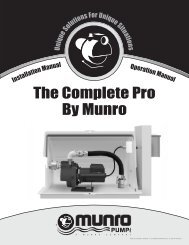Do-it-yourself! FREE Drip Irrigation Installation Guide - Garden Drip ...
Do-it-yourself! FREE Drip Irrigation Installation Guide - Garden Drip ...
Do-it-yourself! FREE Drip Irrigation Installation Guide - Garden Drip ...
You also want an ePaper? Increase the reach of your titles
YUMPU automatically turns print PDFs into web optimized ePapers that Google loves.
DIG provides different emission devices specifically designed to effectively and efficiently irrigate<br />
each plant group. To choose the correct emission device, please refer to the following guidelines:<br />
CATEGORY 1—Trees and Shrubs: Pressure Compensating (PC), button, adjustable and flag<br />
drippers are su<strong>it</strong>ed for virtually any layout w<strong>it</strong>h plants such as shrubs, trees, vines, roses. They are<br />
most efficient when plants are spaced few feet apart (See chart A1, B, and F on pages 10-13 for<br />
recommended number of drippers, dripper spacing per plant or area and maximum length to run the<br />
1/2" polytube and 1/4" microtube). Model G77 is an excellent starter k<strong>it</strong> for this type of installation.<br />
/ ___ / ___<br />
3(<br />
/ ___ 1/4" microtube<br />
/ ___<br />
3) 3$ 3*<br />
3! 3@ 3&<br />
\___<br />
1/2" polytube<br />
\___<br />
6)<br />
CATEGORY 3—Container Plants, Hanging Baskets, and Window Boxes: For containers, potted<br />
plants, and hanging baskets, use #46 pot and basket misters or #37 – .5 GPH button dripper. The<br />
#46 mister is most appropriate for hanging plants and plants that benef<strong>it</strong> from moist foliage. Potting<br />
soils are very porous and misters prevent drainage problems by dispersing the water over a larger<br />
area of the soil surface. The #46 pot and basket mister is an ideal choice for all sizes and shapes of<br />
containers. Larger containers may require more than one mister. (See chart A, A1, B, C, and C1 on<br />
pages 10 and 12 for recommended spacing, flow rates, wetting diameter and pattern). Model MD50<br />
is an excellent starter k<strong>it</strong> for this type of installation.<br />
3&<br />
2% 6% 4^<br />
CATEGORY 4—Vegetable <strong>Garden</strong>s and Row Crops: Earthline Brown PC dripline, drip soaker<br />
tape, and 1/4" laser drilled soaker line are ideal for vegetable gardens, row crops, seed beds,<br />
planters, and narrow planting areas (See chart D on page 12 for maximum length to run). These<br />
products will saturate the soil under the entire length of the dripline or drip tape. An excellent starter<br />
k<strong>it</strong> is the ST100 or Earthline Brown PC dripline w<strong>it</strong>h a 1 GPH dripper every 18".<br />
CATEGORY 2—Flowerbeds and Groundcover: Microsprinklers and microsprayers are best su<strong>it</strong>ed<br />
for densely planted flowerbeds, annuals, groundcovers, groups or clusters of plants, small slopes,<br />
and on s<strong>it</strong>es w<strong>it</strong>h very sandy soil. In sandy soil water will percolate downward before <strong>it</strong> can spread<br />
far enough horizontally (see charts A1, B and F, on pages 10-13 for recommended spacing, flow<br />
rates, diameter, pattern, and maximum length to run 1/2" polytube). Avoid microsprinklers in areas<br />
where <strong>it</strong> is windy; high winds will disturb the microsprinkler spray pattern. Model EF55 and GE200<br />
are excellent for this type of installation.<br />
40’ 40'<br />
14’<br />
14'<br />
26’<br />
26'<br />
28’<br />
28'<br />
42 32 GPH GPH<br />
24<br />
24<br />
GPH<br />
GPH<br />
21<br />
21<br />
GPH<br />
GPH<br />
40<br />
40<br />
GPH<br />
GPH<br />
8'R 8’ up up to to 20' 10’ 7'R 7’ 14’ 13'<br />
.8 1’<br />
14 14 GPH GPH 0-30 GPH<br />
14 14 GPH GPH 10 10 GPH GPH<br />
2 GPH<br />
7 http://www.digcorp.com<br />
9& 9% 4) 4%<br />
4* 9@ 4( 4! 4^<br />
Determine and Calculate Water Flow Requirements<br />
To determine the total flow w<strong>it</strong>hin a drip system section or zone, add up the total number of<br />
drippers and their flow rates. The same method should be used for microsprinklers and<br />
microsprayers.<br />
Example: You have designed a system using 40 drippers, consisting of 20 – 1 GPH and 20 – 2 GPH<br />
drippers, plus 2 microsprinklers at 14 GPH each.<br />
Calculate total flow rates:<br />
20 – 1 GPH drippers = 20 gallons per hour<br />
20 – 2 GPH drippers = 40 gallons per hour<br />
2 – 14 GPH microsprinklers = 28 gallons per hour<br />
Total flow rate = 88 Gallons Per Hour (GPH), or (dividing by 60) = 1.46 Gallons Per Minute (GPM)<br />
TIP: The maximum recommended flow rate for a single line of 1/2"<br />
polytube is 220 GPH (3.6 GPM). If you exceed the recommended flow<br />
rate, add another line of 1/2" polytube to your zone or section.<br />
If the flow rate from a single valve or a zone using a 3/4" pipe exceeds 9 GMP (540 GPH), another<br />
valve or zone should be added. This can be done by dividing the area to be irrigated in half and build<br />
a valve manifold for each new zone. Another option is to consider using a valve or a zone for each<br />
type of application. For example, one valve can be used w<strong>it</strong>h your drip layout and one valve w<strong>it</strong>h a<br />
microsprinkler layout.<br />
TIP: The recommended flow rate for any section or a zone using 3/4"<br />
valve is 540 GPH or 9 GPM. If using w<strong>it</strong>h a Model 9001 controller the<br />
maximum flow rate is 312 GPH or 5.2 GPM.<br />
Questions – Call 1-800-344-2281<br />
8



